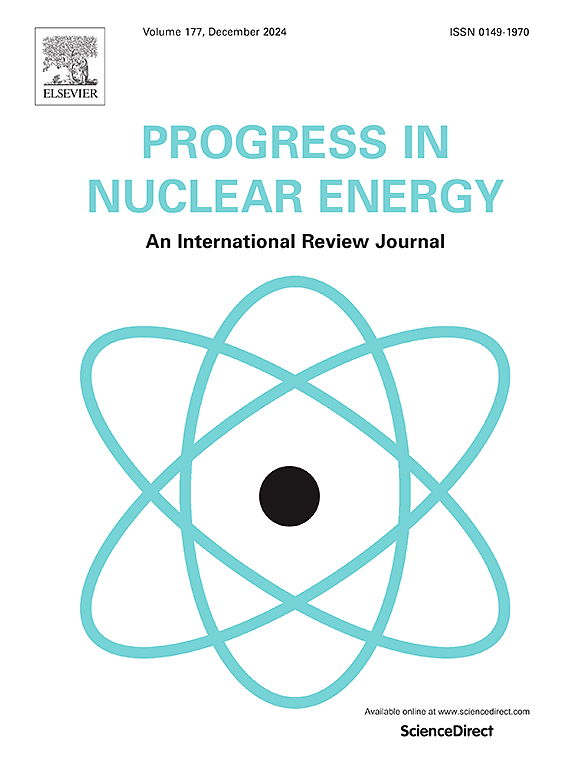基于高效CFD-ROM方法的核电棒束沸腾流参数快速预测研究
IF 3.3
3区 工程技术
Q1 NUCLEAR SCIENCE & TECHNOLOGY
引用次数: 0
摘要
过去,计算流体动力学(CFD)被广泛用于验证杆束通道内的流动动力学。然而,迭代计算和时间消耗使得数字孪生对效率的要求不现实。为了解决这一难题,我们建议利用数据驱动的降阶模型(ROM)来快速预测杆束通道的流场。以往对棒束通道的降阶模型的研究主要集中在单相状态,对两相状态的研究较少。因此,本文主要研究两相状态下棒束通道的ROM。首先,利用适当正交分解(POD)算法对计算流体动力学(CFD)数据集进行处理,识别重要模态;然后,由于反向传播神经网络(BPNN)模型具有较强的拟合输入和输出之间非线性关系的能力,因此将其训练为智能体模型。对BPNN的结构进行了优化。最后,利用ROM模型对新边界条件下的杆束通道流场进行了预测。与CFD计算的对比证实了降阶模型(ROM)的有效性,表明其在预测杆束通道内的温度、速度和空隙率场方面具有很高的精度。此外,ROM模型的计算速度大约比标准CFD模拟快10^4倍。尽管如此,值得注意的是,由于缺乏样品,该模型的预测精度在轻微过冷沸腾的条件下降低。改进策略:根据不同的变化阶段细分采样空间区域,实现分区采样。本文章由计算机程序翻译,如有差异,请以英文原文为准。
Research on fast prediction of boiling flow parameters in rod bundle of NPP based on efficient CFD-ROM methods
Historically, Computational Fluid Dynamics (CFD) has been widely used to verify the flow dynamics in rod bundle channels. Nevertheless, the iterative calculation and time consumption make it impractical for the application of digital twin that require efficiency. In order to tackle this difficulty, we suggest utilizing a data-driven order reduced model (ROM) to rapidly predict flow fields of rod bundle channels. Previous research on Reduced Order Models (ROM) for rod bundle channel has primarily focused on the single-phase state, with little emphasis on the two-phase state. Thus, the study focuses on the ROM of rod bundle channel in a two-phase state. First, a Computational Fluid Dynamics (CFD) data set is processed using the Proper Orthogonal Decomposition (POD) algorithm to identify important modes. Then, a Back-Propagation Neural Network (BPNN) model is trained as the agent model, due to its strong ability to fit non-linear relationship between input and output. The structure of BPNN is optimized. Ultimately, the ROM model is utilized to predict the flow field of a rod bundle channel under new boundary conditions. The comparison with CFD calculation confirms the effectiveness of the Reduced Order Model (ROM), showcasing its high precision in predicting the temperature, velocity, and void fraction fields within the rod bundle channel. In addition, the ROM model reaches a computation speed that is roughly 10^4 times quicker than standard CFD simulations. Nonetheless, it is noted that the model's predictive accuracy diminishes under conditions of slight subcooled boiling, due to the lack of samples under the condition. An improvement strategy: Subdivide the sampling space region according to various change stages, implement partition sampling.
求助全文
通过发布文献求助,成功后即可免费获取论文全文。
去求助
来源期刊

Progress in Nuclear Energy
工程技术-核科学技术
CiteScore
5.30
自引率
14.80%
发文量
331
审稿时长
3.5 months
期刊介绍:
Progress in Nuclear Energy is an international review journal covering all aspects of nuclear science and engineering. In keeping with the maturity of nuclear power, articles on safety, siting and environmental problems are encouraged, as are those associated with economics and fuel management. However, basic physics and engineering will remain an important aspect of the editorial policy. Articles published are either of a review nature or present new material in more depth. They are aimed at researchers and technically-oriented managers working in the nuclear energy field.
Please note the following:
1) PNE seeks high quality research papers which are medium to long in length. Short research papers should be submitted to the journal Annals in Nuclear Energy.
2) PNE reserves the right to reject papers which are based solely on routine application of computer codes used to produce reactor designs or explain existing reactor phenomena. Such papers, although worthy, are best left as laboratory reports whereas Progress in Nuclear Energy seeks papers of originality, which are archival in nature, in the fields of mathematical and experimental nuclear technology, including fission, fusion (blanket physics, radiation damage), safety, materials aspects, economics, etc.
3) Review papers, which may occasionally be invited, are particularly sought by the journal in these fields.
 求助内容:
求助内容: 应助结果提醒方式:
应助结果提醒方式:


